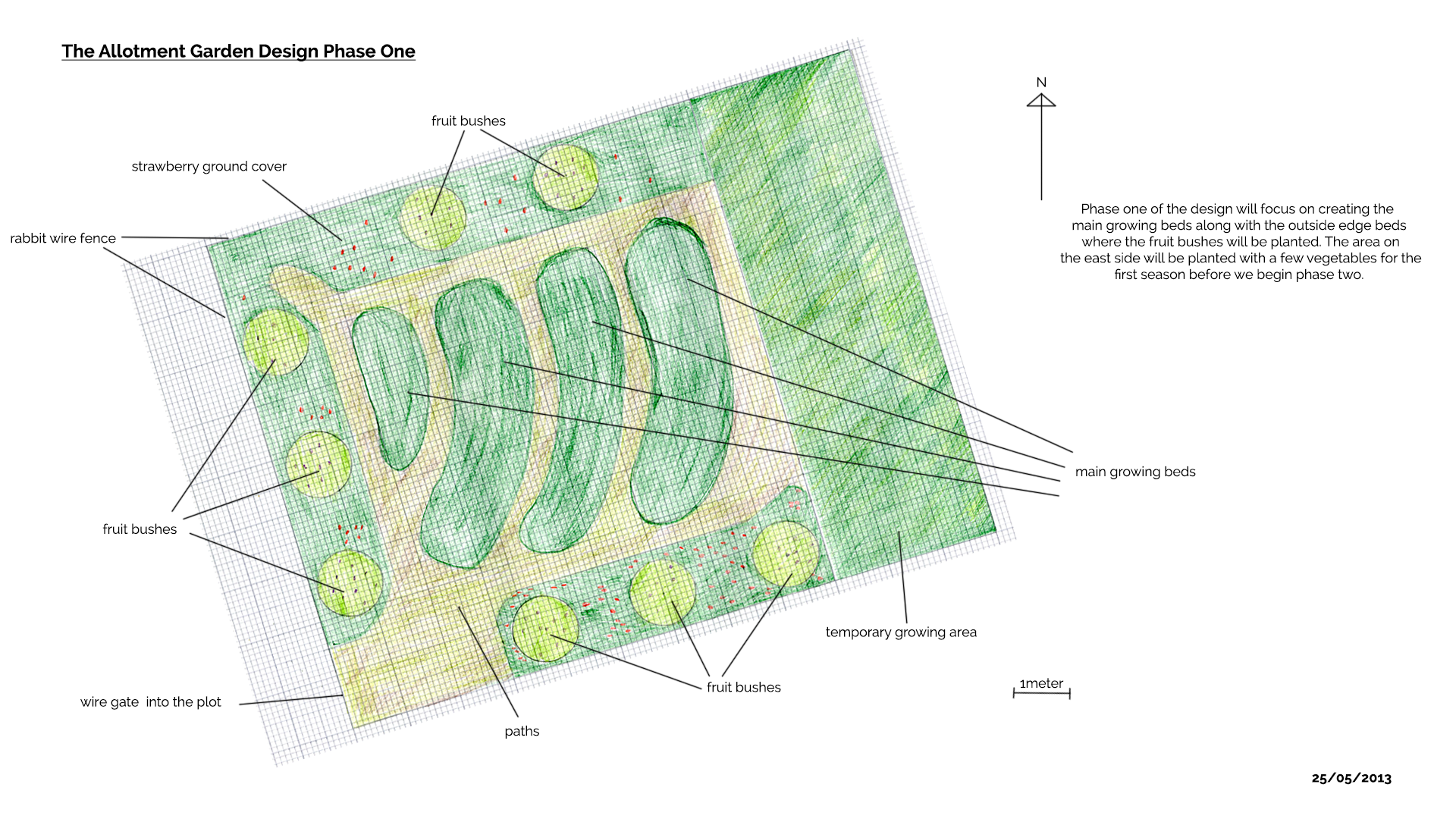Allotment Garden Design Proposal

Aims of the design
Grow organic fruit and vegetables
An area for relaxation
Habitat for wildlife
Low maintenance
Design concepts
Themes
- No-dig gardening
- Focus on perennials
- Forest garden design
- wildlife garden
The design will be to create raised soil beds by digging the soil from the paths and using this soil to build the beds. Once the beds have been built we will follow the no-dig gardening theme, (see appendix) allowing the soil microbiome (see appendix) to get established. The only digging will be to add plants into the garden and some lifting of root crops using a fork.
Having a focus on edible perennial plants (see appendix) will also help to limit the amount of soil disturbance throughout the garden. Perennials are more resistant to drought having deep roots that give them better access to groundwater, this will be an advantage because once established the plot will not be getting hand watered.
Using the raised beds and working with perennial crops, a forest garden design method of gardening (see appendix) will be implemented. Fruit bushes will be planted around the edge of the allotment plot with an under-story of strawberries. The beds in the middle of the plot will be planted with a diverse variety of other food crops with a focus on plants that do not need to be hand-watered once established.
With the forest garden design method creating a habitat for wildlife will fit in very well with the rest of the design. The planting method of growing many different types of plants in the same bed and growing perennials will reduce the need to keep disturbing the beds allowing wildlife to become established. There will also be lots of opportunities to grow many varieties of flowering plants with the forest garden design, these will be of great value to the bees and other insects.
Layouts
Design Details
Phase One Season One
- Weed the plot
- Fence the plot
- Mark out the design
- Dig out the paths to make the beds
- Plant out the temporary growing area
- Sow the beds with cover crops
- Chop and drop the cover crop
- Plant the fruit bushes and strawberry plants
Weed the plot: Taking a little extra time to weed the plot will be important to try to keep the weed growth down to a minimum. The site is showing all the signs of a recently ploughed and rotavated soil. Care should be taken to remove as many of the roots as possible of the grass and docks. (see appendix)
Fence the plot: The allotment site is open to the hedgerow, allowing free access to the site for rabbits. It will be necessary to fence the plot with rabbit wire to avoid the crops getting eaten. Fencing the site will be easier before any landscaping work in carried out. (see appendix)
Mark out the design: Before any landscaping is started it is important to mark out the design using pegs and string. This not only allows the design to be laid out correctly but it's much easier doing it whilst the earth is still flat. Once the soil has started to be moved, without marking out the design it is easy to lose sight of where each of the elements needs to go.
Dig out the paths to make the beds: The soil for the beds is going to come from digging paths into the plot. Using the pegs and string as a guide the soil should be laid out to form a mound-shaped bed. The paths will need to be deep enough to be able to have ample soil for each bed. Any large boulders can be hidden deep in the base of these beds. Extra time will be needed to break up any large chunks of compacted clay. During this work, any missed weed roots should also be removed from the soil. (see appendix -Paths and Beds)
Plant up the temporary growing area: A temporary growing area has been set aside for some quick return crops whilst the larger area of the plot is been landscaped. (see appendix)
Sow the beds with cover crops: Once the beds are complete sowing them with a cover crop will help to improve the soil. It is also mid-June and getting too late in the season to be planting the beds with crops for this year. (see appendix)
Chop and drop the cover crop: In autumn using the chop and drop method of mulching (see appendix) the beds will have ample cover over the winter months to give protection to the soil and helping the soil microbiome (see appendix) to get more established.
Plant the fruit bushes and strawberry plants: Winter is a good time to plant the type of fruit bushes we wanting to grow in the plot (see appendix). Once again following the design plan these bushes can now be planted. Weather permitting the strawberry plants can also be put into the ground. (see appendix)
Phase One Season Two
- Plant up the beds
- Chop and drop
Plant up the beds: After the last of the frosts it will now be time to start and add some plants to the growing beds.
Chop and drop mulching: Following on from the cover crops sown last season, there will be plants that will need to be chopped, dropped and mulched (see appendix) back into the soil helping to keep moisture in the soil and as part of the soil food web. (see appendix)
Phase Two Season One
- Sow cover crop
- Peg and mark out the path and growing bed
- Dig out compost area
- Dig out path and area for the seat
- Form the growing bed
Late summer
Sow cover crop: Sow a cover crop (see appendix) over the temporary vegetable growing area. This will not affect any vegetables which are still growing.
November
Peg and mark out the path and growing bed: Before digging out the composting area peg and mark out with string the area that is going to be the bed. Any remaining area will be paths and the seating area. It’s important to do this because the soil from the compost area is going to help build the raised bed. Once the bed is marked out the soil can be moved directly onto this bed.
Dig out the compost area: Following the design dig out the location where the composting area is the go (see appendix). The soil can be moved onto the area marked out for the growing bed.
Dig out path and area for the seat: Following the already marked out areas, dig on the remaining paths and the area where the seat is going to go. The cover crop that is growing in this area can be dug directly into the soil.
Form the growing bed and mulch it: This bed should have the highest mound of soil due to the quantity of soil moved to make room for the seating and the compost areas. The soil can be evenly laid out giving the seating area a more secluded feel to it with a high soil mound at the back of it. With the bed finished, add a cover of mulch to protect the soil during the winter.
Phase Two Season Two
- Add a seat
- Plant up the growing bed
Add a seat: Early spring would be a good time to add a seat to the area designed for relaxing in.
Plant up the growing bed: The soil be will now be ready for planting up. This will be a good bed to add perennial plants with a focus on tall plants to give some privacy to the open plot (see appendix).
Year three and so on
With the design phases complete the coming years will focus on improving the soil with compost mulches and continuing with the chop and drop mulching. I will also be looking to add more perennial food plants (see appendix) into the system along with some extra fruit bushes.
Design – Maintenance
As part of this design, one of the main requirements was for it to be low maintenance. I will only be able to visit the allotment plot on weekends so some of these times I expect to be at the plot for several hours catching up on such jobs as;
Through the growing season
- Weeding the plot
- Planting out
- Watering in new plants
- Harvesting
- Chop and drop mulching
- Turning the compost heap
Weeding the plot: Even with a focus on wildlife habitat, it’s going to be important to keep on top of any weeds that grow in the garden. Weeds are unwanted plants that reduce the yields of food crops by using up nutrients from the soil and once established will crowd out other plants. Due to the location of the allotment site, we are always going to have new weed seeds blowing in on the wind. The soil will also already have an abundance of seeds stored in it waiting for the correct conditions to germinate.
Planting out: Most of the crops that get planted at the plot will have first been grown from seed off-site. It’s not practical to grow most seeds at the allotment site due to only visiting at weekends. Planting out can be a time-consuming job and will be at a time when the plants are ready. Planting out to soon or to late can have negative affects on the young plants and can result in lower yields. Planning in these days will be important to the health of the allotment plot.
Watering in new plants: Once planted out new plants will need some water the following days to help them get established if the weather is dry. During this time I will rely on my partner popping up on an evening to water. Choosing the correct plants that do not need very much water will need to be taken into consideration to prevent unnecessary water usage and time spent watering.
Harvesting: Crops such as berries will need to be picked when ripe, consideration will need to be taken and time planned around berry harvesting. This will involve weekends and weekdays, once again I will have to rely on my partner coming up to the allotment on weekdays during the harvesting window to collect the berries. Most other crops will not require such precise harvesting time so weekends will work out fine.
Chop and drop mulching: As part of the general weekly weeding program, chopping and dropping any plants that are not needed can be done at the same time.
Turning the compost heap: The compost heap at the allotment is going to be a cold compost heap but it will still need to be turned every once in a while.
Outside of the growing season
- Adding compost to the beds
- Cutting back
- Weeding
Adding compost to the beds: A yearly dig out of the compost area and the contents laid out over the growing beds will need to be carried out. Not a major job regarding time and effort but one that will add value to the beds.
Cutting back: During the winter months, a cutback can be carried out dropping anything that no longer needs to be standing upright in the garden. The cut of material can be left to compost back into the ground from where it was cut.
Weeding: Winter is a great time for couch grass to grow, a quick sweep of the plot for grass will save time later in the year once the grasses have got themselves established. Weeding at any time of the year is the best way to get to know the health of a garden. When spending time amongst the plants whilst weeding you often notice many things you would have normally missed by just looking over the plants from above. Tip: A good audiobook or podcast can make weeding the garden into a very enjoyable job.










